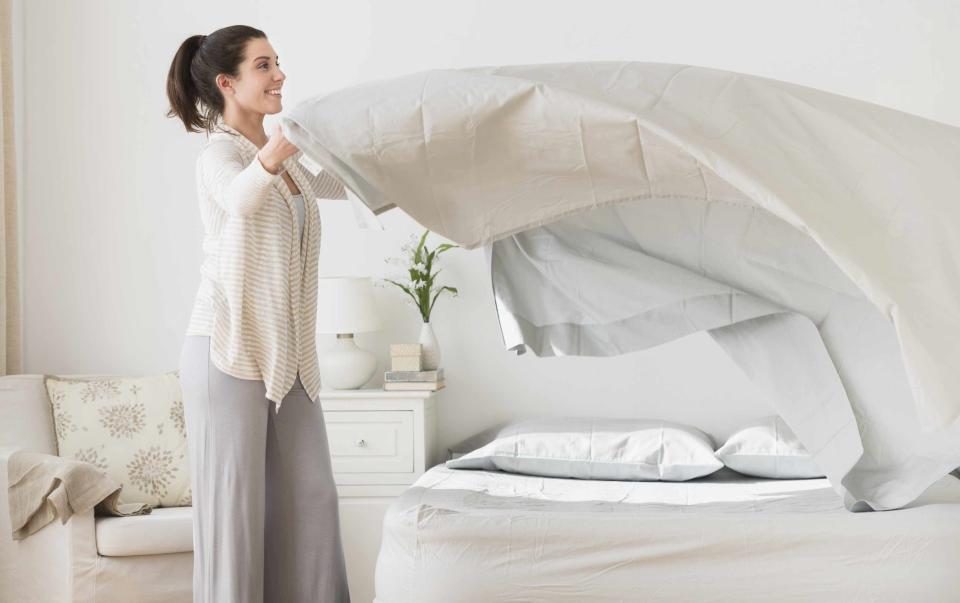Have Allergies? These 8 Home Cleaning Tips Can Help
The Spruce's first-ever print magazine, 'Cleaning Made Easy,' provides answers to all your toughest cleaning questions.

Getty Images
The Spruce's first print magazine, "Cleaning Made Easy," offers pro-approved advice, how-tos, and product recommendations to tackle every cleaning challenge—including how to clean to reduce allergens. Follow the tips below to clear away pollen, dust mites, and more. Plus, find recommendations for choosing the best vacuum cleaner for allergies and tips for selecting allergy-friendly cleaning products. Once your home is allergen-free, check out The Spruce's "Cleaning Made Easy" print issue, available everywhere magazines are sold, for more cleaning secrets from the pros.
From The Spruce's "Cleaning Made Easy" Issue:
If you or someone in your home suffers from year-round or seasonal allergies or asthma, you can reduce the misery by cleaning correctly to minimize and remove allergens. (Allergens can be any substance that causes an allergic reaction.)
Related:The 5 Best Air Purifiers, According to Our Testing
Choose Your Vacuum With Care
The type of vacuum you purchase makes a huge difference in allergen reduction. Opt for a fine-particle HEPA filter vacuum, or use a double bag to trap as many particles as possible. A bagless vacuum like the Samsung Jet, which has a sealed cleaning station that automatically empties the collection bin (and you can easily remove and wash the bin), is also a good choice. If allergen avoidance is your goal, consider a robotic vacuum and mop system like Ecovacs Deebot Ozmo N8 Pro+ that offers continuous nighttime cleaning while you are not in the room. Another option worth exploring is a fabric allergen sanitizer vacuum that uses ultraviolet light to kill dust mites and bacteria and then a dual filtration system to eliminate 99.9% of the offenders from fabric surfaces.
Protect Yourself
Opt for disposable or washable masks. Avoid latex gloves; choose cotton-lined rubber gloves instead to prevent skin irritation.
Wash Microfiber Cloths and Mops
Microfiber cloths, especially when dampened, attract dust better than cotton or paper towels, making them a good choice for cleaning all sorts of surfaces. However, as a result, they need to be thoroughly washed in hot water as soon as possible. Similarly, plan to wash mop heads after every use. Look for mopping tools with removable heads that can be tossed in the washer.
Go Disposable
Synthetic dusting wipes and wands attract dust and create static cling that will hold the dust until it can be disposed of in the trash after each use.
Read Labels
For laundry, choose detergents and other stain-removal products that are dye-free and unscented. Studies have shown that dye is often the culprit in skin irritation. For cleaning, look for unscented cleaners and use natural products like distilled white vinegar, baking soda, and lemon juice. Find more cleaning solutions in The Spruce's "Cleaning Made Easy" issue.
Focus on Beds and Bedding
Wash sheets, pillowcases, and blankets at least once a week in hot water. If you have allergies, never hang bedding outside to dry. The outdoor pollens will come in with the sheets. Choose washable bedspreads or comforters and encase pillows, mattresses, and box springs in dust mite-proof cases.
Stop Mold
Halt and remove mold growth, particularly in bathrooms, with homemade or commercial cleaners. Always read directions carefully and NEVER mix different chemicals. Get in the habit of running an exhaust fan or opening a window when taking baths or showers. After every use, towel-dry the tub or shower enclosure. Always hang towels to dry and wash linens frequently to limit mold growth.
Avoid Irritants
Unfortunately, some cleaning products can be irritants and cause the same symptoms as an allergen. Choose cleaning products that contain the fewest chemicals possible, and limit exposure to these potentially irritating chemicals:
Ammonia
D-limonene
Formaldehyde
Sodium hypochlorite
Sodium lauryl sulfate
More Ways to Reduce Allergens
Beyond good, regular cleaning, you can further reduce allergens with the following strategies.
CONTROL INDOOR TEMPERATURE AND HUMIDITY. Dust mites and mold spores thrive in heat and humidity. By maintaining a temperature between 68 ̊F (20 ̊C) and 72 ̊F (22 ̊C) and a humidity level of no more than 50 percent, you can reduce their growth.
USE SMALL-PARTICLE FILTERS. Update your central heating and cooling systems and in-room air conditioners. Change or clean all filters monthly.
REMOVE WALL-TO-WALL CARPETING. Install solid tile or hardwood flooring. Choose washable area rugs.
STOP ALLERGENS AT THE DOOR. At least weekly, clean outside entryways by sweeping or hosing away pollen. Have everyone in the family take off their shoes before going into the house. Store outerwear in an entry area rather than bedrooms to keep pollen at bay.
KEEP PETS OUTSIDE AS MUCH AS POSSIBLE. Bathe indoor pets at least weekly and wash their bedding weekly. Keep pets out of the bedroom and off the bed.
CONTROL PESTS. Use traps or a professional exterminator to deal with rodents and insects. Seal any cracks that may allow them into your home.
DO NOT ALLOW SMOKING ANYWHERE IN THE HOME. Secondhand and residual smoke can be allergens.
PROTECT PLANTS. If you have plants, cover the soil with decorative rocks or marbles to help contain the natural molds that can grow in damp soil. Artificial plants should be dusted weekly and given a shower periodically to remove dust.
For more Real Simple news, make sure to sign up for our newsletter!
Read the original article on Real Simple.

